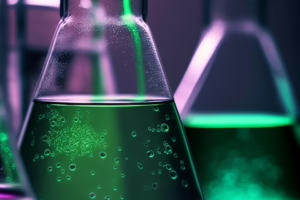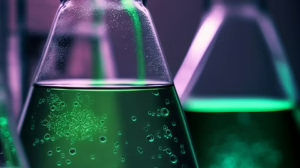Sustainable Chemistry: Revolutionizing Industries for a Greener Future
Introduction
In the face of escalating environmental challenges, sustainable chemistry has emerged as a critical field aimed at promoting eco-friendly practices in various industries. Traditional chemical processes often lead to hazardous waste, toxic byproducts, and unsustainable resource depletion. Sustainable chemistry seeks to address these issues by innovatively integrating principles of sustainability into chemical research and production. This article delves into the significance of sustainable chemistry, its applications across industries, and its potential to revolutionize practices for a greener future.
The Importance of Sustainable Chemistry
1. Environmental Concerns
The impact of traditional chemistry on the environment is profound. Industrial processes have contributed significantly to pollution and degradation of ecosystems. Sustainable chemistry aims to reduce the ecological footprint of chemical processes, emphasizing the use of renewable resources, minimizing energy consumption, and reducing waste.
2. Health Implications
Chemicals are integral to multiple sectors, yet many substances pose risks to human health. Sustainable chemistry focuses on developing safer alternatives that minimize harmful effects on consumers and workers. By prioritizing the design of non-toxic, biodegradable materials, this discipline enhances public health and safety.
3. Economic Viability
Sustainable chemistry not only benefits the environment but also promotes economic sustainability. By adopting green chemistry principles, industries can optimize resource use, reduce costs associated with waste disposal, and meet consumer demand for eco-friendly products. The shift towards sustainability fosters innovation, opening new markets and opportunities.
Principles of Green Chemistry
The foundation of sustainable chemistry lies in the principles of green chemistry, which guide the development of safer and more efficient chemical processes. These principles include:
-
Prevention of Waste: Minimizing waste generation is key. Sustainable chemistry encourages the design of processes that produce little or no waste.
-
Atom Economy: This principle focuses on maximizing the incorporation of all materials used in the process into the final product, thereby reducing waste.
-
Non-Toxicity: Designing chemicals that are non-toxic to humans and the environment is central to sustainable practices.
-
Renewable Resources: Emphasizing the use of renewable feedstocks over non-renewable resources fosters sustainability.
-
Energy Efficiency: Reducing energy consumption is vital for minimizing the environmental impact of chemical processes.
-
Design for Degradation: Chemicals should break down into harmless products after their useful life, minimizing their impact on the environment.
-
Real-Time Analysis: Continuous monitoring of chemical processes ensures safety and efficiency, allowing for immediate adjustments to minimize hazards.
- Inherently Safer Chemistry: Whenever possible, chemical products and processes should be designed to minimize the potential for accidents and exposure.
Applications of Sustainable Chemistry
1. Pharmaceuticals
The pharmaceutical industry is a major sector where sustainable chemistry principles are making significant inroads. Traditional drug synthesis often involves hazardous reagents and produces toxic waste. Innovators in this field are developing greener processes through:
- Catalysis: Employing catalysts to enhance reactions while reducing energy consumption and byproducts.
- Biocatalysis: Utilizing enzymes for drug synthesis, leading to milder reaction conditions and fewer toxic substances.
- Solvent-Free Processes: Developing methods that eliminate the need for solvents, thereby decreasing waste.
2. Agriculture
Sustainable chemistry plays a pivotal role in advancing agricultural practices. Researchers are focusing on:
- Biopesticides and Bioherbicides: These alternatives to synthetic chemicals are less harmful to the environment.
- Sustainable Fertilizers: Creating organic fertilizers that reduce chemical runoff into water sources.
- Precision Agriculture: Implementing smart technologies to optimize resource use and minimize chemical inputs.
3. Materials Science
The development of sustainable materials is a key focus area. Innovations include:
- Bioplastics: Derived from renewable resources, bioplastics provide a more sustainable alternative to traditional plastics.
- Recyclable Materials: Designing materials that can be reprocessed and reused reduces waste and resource extraction.
- Smart Materials: Materials that adapt to environmental changes can enhance energy efficiency and performance.
4. Energy
In the energy sector, sustainable chemistry is revolutionizing the production and use of fuels. Key advancements include:
- Biofuels: Developing fuels from renewable biomass sources, such as algae, which can significantly lower carbon emissions.
- Energy Storage: Innovations in batteries and fuel cells that utilize sustainable materials and processes to improve efficiency and reduce reliance on fossil fuels.
5. Textiles
The textile industry is notorious for its environmental impact. Sustainable chemistry is transforming this sector through:
- Eco-Friendly Dyes: Developing non-toxic dyes and finishing processes that minimize water usage and pollution.
- Sustainable Fibers: Innovations in producing fibers from renewable resources, reducing dependence on petroleum-based materials.
Challenges and Barriers to Adoption
Despite the promising potential of sustainable chemistry, several challenges impede its widespread adoption:
1. Regulatory Hurdles
The regulatory landscape can be slow to adapt to new technologies, hindering the commercialization of sustainable products.
2. Economic Constraints
While sustainable methods can reduce costs in the long run, initial investments may be high, deterring companies from transitioning to greener practices.
3. Awareness and Education
Lack of awareness about the benefits of sustainable chemistry among industry stakeholders and consumers can limit market demand for green products.
4. Technical Limitations
Developing efficient sustainable processes and materials that meet performance standards is a complex challenge requiring substantial research and development efforts.
5. Market Competition
Established chemical processes and products have a significant market presence, making it difficult for sustainable alternatives to gain traction.
Future Directions in Sustainable Chemistry
As sustainable chemistry continues to evolve, several trends are emerging that have the potential to reshape industries:
1. Digitalization and Automation
The integration of digital technologies is enhancing the efficiency and scalability of sustainable chemical processes. Automation can lead to significant reductions in waste and energy consumption.
2. Circular Economy
Emphasizing a circular approach, sustainable chemistry can facilitate the transformation of waste into resources, promoting recycling and reusability.
3. Collaboration Across Sectors
Cross-disciplinary collaboration is essential for addressing complex sustainability challenges. Partnerships between academia, industry, and government can accelerate innovation in sustainable practices.
4. Education and Outreach
Educational initiatives aimed at raising awareness about sustainable chemistry will be crucial in fostering a culture of sustainability among future generations.
5. Policy Support
Proactive policies that incentivize sustainable practices, including subsidies for green technologies, can catalyze the transition to sustainable chemistry.
Conclusion
Sustainable chemistry is not merely a trend; it is a necessary evolution in how industries operate in an increasingly resource-constrained world. By adopting green chemistry principles, industries can lead the way towards a greener, healthier future. The path may be fraught with challenges, but through collaboration, innovation, and a commitment to sustainability, we can revolutionize industries for the betterment of our planet.
References
- [1] Anastas, P. T., & Eghbali, N. (2010). Green Chemistry: Principles and Practice. Chemistry International.
- [2] Benvenuti, T. (2019). Sustainable Chemistry: Innovative Approaches for Green Chemistry. Chemistry Reviews.
- [3] Garett, M., & Fennell, P. (2021). The Role of Sustainable Chemistry in Achieving Global Climate Goals. Journal of Environmental Protection.
- [4] Houghton, R. A. (2021). Implementing Green Chemistry in the Chemical Industry. Sustainability Journal.
- [5] Lankveld, W. (2020). Innovations in Renewable Resources for Sustainable Chemistry. Journal of Cleaner Production.
By harnessing the principles of sustainable chemistry and advocating for a collective shift towards greener practices, industries can not only ensure their compliance with environmental standards but also contribute positively to the well-being of the planet and its inhabitants.


























Add Comment